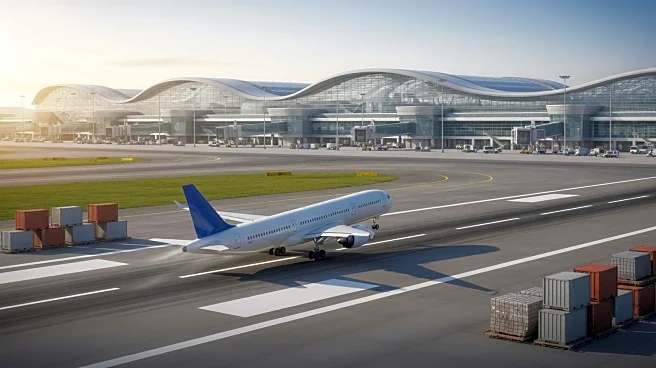What's Happening?
Entebbe International Airport in Uganda has achieved record passenger and cargo growth, as reported by the Uganda Civil Aviation Authority (UCAA). In August, the airport recorded 243,089 international
passengers, surpassing the previous month's total. Cargo movements have also increased, driven by exports of flowers, fish, and manufactured goods. The growth is attributed to factors such as international conferences, tourism promotion, and new flight connections. The airport is undergoing a $125 million expansion to meet demand, including a second passenger terminal and facility upgrades, aiming to increase capacity to 3.5 million passengers annually.
Why It's Important?
The expansion and growth at Entebbe Airport are significant for Uganda's economy and regional connectivity. Increased passenger and cargo traffic can boost tourism and trade, enhancing economic development. The airport's expansion is expected to improve safety and efficiency, attracting more international airlines and passengers. This growth can position Uganda as a key player in regional aviation, fostering economic ties and facilitating exports. The development aligns with Uganda's broader goals of economic diversification and infrastructure improvement, potentially leading to increased foreign investment and job creation.
What's Next?
The ongoing expansion at Entebbe Airport is set to continue, with a long-term target of handling five million passengers by 2029. As the airport enhances its capacity, it may attract more airlines and routes, further boosting passenger numbers and cargo volumes. The increased connectivity could lead to more international conferences and tourism activities, supporting Uganda's economic growth. Stakeholders, including the government and aviation industry, will likely focus on maximizing the benefits of this expansion, ensuring sustainable growth and addressing any infrastructure challenges.
Beyond the Headlines
The airport's expansion may have broader implications for regional aviation and economic integration. Improved connectivity can facilitate trade and investment across East Africa, promoting regional cooperation. The development may also influence environmental and sustainability practices, as increased traffic necessitates efficient resource management. Additionally, the expansion could impact local communities, offering employment opportunities and enhancing infrastructure. The project highlights the importance of strategic planning in aviation development, balancing growth with environmental and social considerations.











